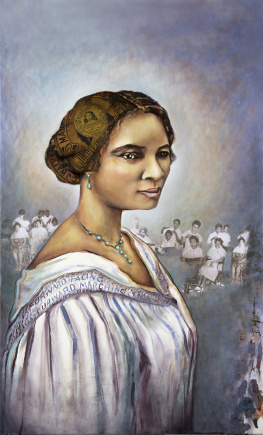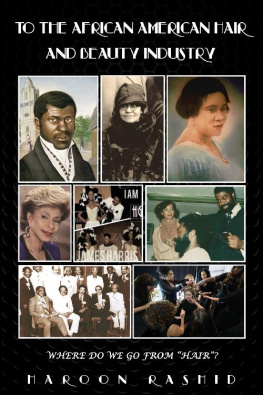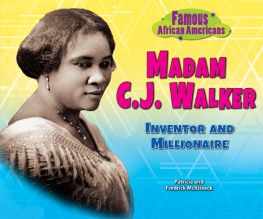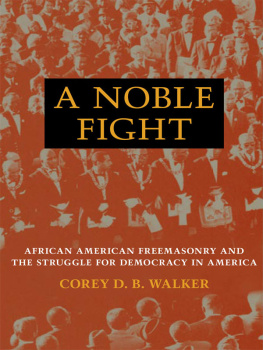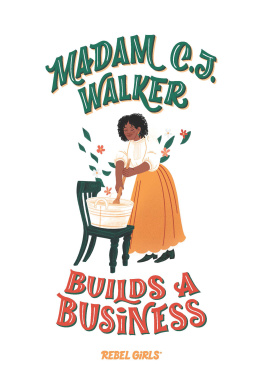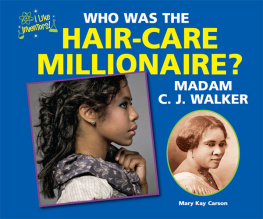Erica L. Ball is a professor of history and Black studies at Occidental College. Focusing on the ways African Americans have placed visual, print, and other forms of cultural production in the service of the long freedom struggle, her work explores the connections between African American expressive culture, class formation, and political activism in the nineteenth and twentieth centuries. Ball is the author of To Live an Antislavery Life: Personal Politics and the Antebellum Black Middle Class (2012) and co-editor, with Kellie Carter Jackson of Reconsidering Roots: Race, Politics, and Memory (2017). She is also co-editor, with Tatiana Seijas and Terri L. Snyder of As If She Were Free: A Collective Biography of Women and Emancipation in the Americas (2020).

This book was shaped by numerous conversations with friends and colleagues on campus, at conferences, at the Huntington Library, and most recently, over Zoom. Thank you to Courtney Baker, Carol Berkin, Mijin Cha, Ross Lerner, Ainsley LeSure, Delia Mellis, Chandra Prescod-Weinstein, Tatiana Seijas, Terri Snyder, and Peter Vellon for offering encouragement, keeping me accountable, and helping me to think through various aspects of this project. Conference chats with Tyrone Freeman and ALelia Bundles were illuminating and very much appreciated. I am especially grateful to Kellie Carter Jackson, Sharla Fett, Tyler D. Parry, and Justin Gomer for reading chapters as the project developed. A special shout out goes to Kathleen Feeley who not only helped me better understand early twentieth-century celebrity culture, but also read and commented on the entire manuscript. Thank you to the Rowman & Littlefield team, especially John David Smith, Jon Sisk, Benjamin Knepp, and Elaine McGarraugh, all of whom exhibited extraordinary patience with me as I ever so slowly moved this manuscript to completion.
Thank you to Doug Remley at the Smithsonian National Museum of African American History and Culture, and the staff at the Indiana Historical Society and the Denver Public Library. Funding from the Occidental College Faculty Enrichment Grant program and California State University, Fullertons General Faculty Research Fund providing funds that helped to complete the project.
Thank you to the Norton, Doronio, and Ball families. Special thanks to my sister, Stephanie Ball and her husband Tom Sitzler for shepherding me around St. Louis and Denver and always sharing their good cheer and optimism. Its been fourteen years now, and Abby continues to nap next to me as I tap away on my laptop. She is a good dog. Brian Michael Norton remains my very best editor, best friend, and best everything. Always.
My parents, Gene and Carolyn Ball, have given me more than I can ever say. Mom and Dad: this book is for you.
The Madam C. J. Walker Papers at the Indiana Historical Society are instrumental for any study of Madam Walker. So too is the Madam Walker and ALelia Walker family archive maintained by Madam Walkers great-great-granddaughter ALelia Bundles.
There are several biographies of Madam Walker. Of these, the most comprehensive cradle-to-grave overview of Madam Walkers life remains On Her Own Ground: The Life and Times of Madam C. J. Walker (New York: Scribner, 2001), by Madam Walkers great-great-granddaughter ALelia Bundles. This biography was republished under the new title Self-Made: Inspired by the Life of Madam C. J. Walker (New York: Scribner, 2020). Tyrone McKinley Freemans dissertation, The Gospel of Giving: The Philanthropy of Madam C. J. Walker (Indiana University, 2014) offers a thoughtful analysis of Madam Walkers philanthropic activities. For a more speculative account of Madam Walkers early life and career, see novelist Beverly Lowrys Her Dream of Dreams: The Rise and Triumph of Madam C. J. Walker (New York: Knopf, 2003).
In addition to drawing upon these biographies, this volume has been shaped by recent scholarship theorizing the politics of black womens beauty culture. The following texts have proved to be essential to all the chapters in this volume: Noliwe Rooks, Hair Raising: Beauty, Culture, and the African American Woman ( New Brunswick, NJ: Rutgers University Press, 1996); Tanisha C. Ford, Liberated Threads: Black Women, Style, and the Global Politics of Soul (Chapel Hill: University of North Carolina Press, 2015); Susannah Walker, Style and Status: Selling Beauty to African American Women, 19201975 (Lexington: University Press of Kentucky, 2007); Tiffany M. Gill, Beauty Shop Politics: African American Womens Activism in the Beauty Industry (Urbana: University of Illinois Press, 2010); Blain Roberts, Pageants, Parlors, and Pretty Women: Race and Beauty in the Twentieth-Century South (Chapel Hill: University of North Carolina Press, 2014). For scholarship that places Madam Walker in the context of the larger history of the rise of the beauty industry in the United States, see Kathy Peiss, Hope in a Jar: The Making of Americas Beauty Culture (New York: Metropolitan Books, 1998).
Chapter 1
In addition to relying upon the biographies by Bundles and Lowry, the following sources offered insight into the larger context shaping Madam Walkers family history during slavery and immediately after emancipation in Reconstruction-era Louisiana.
On the expansion of slavery, capitalism, and the impact of the domestic slave trade, see Walter Johnson, Soul by Soul: Life inside the Antebellum Slave Market (Cambridge, MA: Harvard University Press, 1999); Walter Johnson, River of Dark Dreams: Slavery and Empire in the Cotton Kingdom (Cambridge, MA: Belknap Press, 2013); Ira Berlin, The Making of African America: The Four Great Migrations (New York: Viking Penguin, 2010); and Edward E. Baptist, The Half Has Never Been Told: Slavery and the Making of American Capitalism. (New York: Basic Books, 2014).
On the folk customs and practices of the enslaved, see Charles Joyner, Down by the Riverside: A South Carolina Slave Community (Champaign: University of Illinois Press, 1984) and Sharla M. Fett, Working Cures: Healing, Health, and Power on Southern Slave Plantations (Chapel Hill: University of North Carolina Press, 2002). For information on African-descended beauty rituals in the context of slavery and emancipation, see Stephanie M. H. Camp, Closer to Freedom: Enslaved Women and Everyday Resistance in the Plantation South (Chapel Hill: University of North Carolina Press, 2004); Thavolia Glymph, Out of the House of Bondage: The Transformation of the Plantation Household (Cambridge: Cambridge University Press, 2008); Shane White and Graham White, Stylin: African American Expressive Culture from Its Beginnings to the Zoot Suit (Ithaca, NY: Cornell University Press, 1999). Additional context about life as a slave in Louisiana was provided by Solomon Northups personal memoir of his kidnapping and captivity, Twelve Years a Slave: Narrative of Solomon Northup, a Citizen of New York, Kidnappedin Washington City in 1841 and Rescued in 1853, From a Cotton Plantation Near the Red River in Louisiana (Auburn, NY: Derby and Miller, 1853).
For discussions of the experiences of enslaved and recently freed African Americans during the Civil War and Reconstruction era, see Jacqueline Jones, Labor of Love, Labor of Sorrow: Black Women, Work, and the Family from Slavery to the Present (1985; rev. ed., New York: Basic Books, 2010); Leon F. Litwack,


